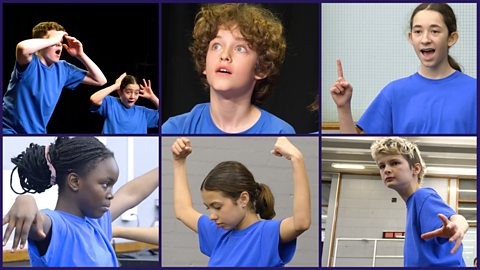Unit 2 explores the theme 'Lights! Camera! Actions!' Dance expert Claire Pring works with a Year 8 class and their teacher to develop dances about action movies.
Go to the for full details of how to use the CPD film (for teachers) and both the Dance Challenge and Dance Performance films below (for teachers and students).

Lights! Camera! Actions! - CPD film for teachers
Claire Pring joins a Year 8 class to develop their dances about action movies.
Claire Pring: Today I’m visiting this secondary school to work with a wonderful Year 8 class and their PE teacher, Kat.
Kat (teacher): …I’d like you to create a shape that conveys ‘powerfulness’. Go, that’s wonderful. This time, I want you to…
Claire: They’ve been working on the theme of ‘action movies’ to develop their choreographic and performance skills.
Kat: OK, how can we show that we are ‘brave’? I’m going to count you this time so we’re going to have to the count of 8 to get into and hold our ‘brave’ position. 1, 2, 3, 4, 5, 6, 7, 8. Lovely.
Claire: So, now you’re going to take 8 counts to find a way to melt into ‘Thoughtful’. If you want to, you can just melt directly into your next shape, but you can add turns, twists, you can add stretches and balances in there as you go. Are you ready? And 1, 2, 3, 4, 5, 6, 7 and 8. Fantastic, well done everybody.
Claire: Already in the warm up, the students are developing their performance skills – to communicate the style of an action movie.
Student 1: Maybe we could do like, I feel like two people racing and then two people, like in a relay, and like one person (holds out arms)
Student 2: Like cheering.
Claire: The students get into groups of different sizes and decide on three action hero characteristics.
Kat: So what are our three actions?
Student 3: Determined, Courageous, Hope, Joy.
Kat: Wonderful, and is everyone joyful at the end?
Student 3: No.
Student 1: (Out of shot) Half and half.
Student 2: Them three are happy but us two aren’t.
Kat: So, you’re showing emotions.
Students: Yeah.
Kat: You’ve got a contrast to your emotions there at the end, haven’t you?
Students: Yeah, yes.
Kat: Like, you are happy, joyful, and you’re…
Student 1: (Edge of shot) In pain.
Kat: In pain, sad, and how else might you feel? How could you describe that?
Student 3: We could be like amazed. Maybe…
Student 2: Shocked.
Kat: Shocked or dismayed.
Student 4: Shocked is like a word for both though, because we’re shocked that we won, they’re shocked that they lost.
Kat: That’s right actually.
Students: We could use that.
Student 3: Determined, Hope, Courageous, Shocked.
Kat: OK, so the shocked when we’re going for the ending, let’s make it very clear.
Kat (To Claire): So in a mixed ability class like this where they’re really enthusiastic and keen, does it matter how you mix the groups up?
Claire: When you’re doing work where they’re close together, it is important that they feel comfortable with one another, so you need to have that as a consideration when you organise who goes with who.
Kat: Yup.
Claire: So, the nice thing about having different group sizes means that you’ll get different choreographic variations going on. So, that will automatically give more interest to the work and just more challenge to it.
Claire: (To students) What kind of formation are you in? how close together are you, how far apart do you need to be, what formation are you going to use that’s effective to communicate your words, these character traits that we’re thinking of?
Claire: The spatial content of dance includes the size of the movements as well as the shapes, the direction, and levels. Students should also be working on pathways if there are travelling movements.
Kat: You’ve really worked on that well, that’s brilliant. What do you think you’ve added to that?
Student 1: We’re trying to make sure that like one of us is like in front of the other instead of being like right next to each other.
Kat: Yeah, and you’ve moved yourselves closer together (students: yeah) which is really lovely. That’s really powerful, I love it. When you’re finishing your last action, just think about the levels (students: right), so your finishing position is quite close to each other (students: yeah) – think about how you could maybe work on that (students: OK). You’ve made your movements much more powerful now which is great (students: right, cool).
Student 2: For the last one like maybe I could stand further back to get some levels.
Student 1: Yeah.
Student 2: Maybe we could try that…
Claire: (To students) Next thing I want you to think about and lots of you are doing this already so it’s brilliant, is your dynamics. It’s how you do an action. And you might want to really think about the words that you have chosen because some of them imply, I think, a certain dynamic. So, all the way through just think about how you’re going to apply dynamics to it to give it some light and shade.
Student 1: One more time from the beginning, ready.
Student 1 (While dancing) One, two, OK.
Claire: Yes, yes, yes. Well done, what’s your next bit that you had after that?
Student 2: …she kicks me…
Student 1: Yeah, then I draw off injured…and then I kick her…
Claire: Lovely! (To student 1) Do that in slow motion. You’ve got the control for it, I know you have, yeah.
Student 1: Slow motion, ready…
Claire: Beautiful, well done! (To student 2) That little moment of suspension before you fell…looked great as well. Keep that in. That’s looking very good. You’ve really got your three different words, those character traits in there, nice and clear.
Claire (To students) The next thing I want you to think about is how you relate to one another. So, some of you have got some mirroring in there, I noticed one group has definitely got some contact work in there. You might also want to use what’s called question and answer, and that has a kind of conversational feel to it. So think about your relationships this time, over to you please.
Claire: Dance is a route into cultural learning. Here the students have chosen a popular ‘spy movie’ theme, that allows for the exploration of conflict in a safe context.
Claire (To students) So, you are the peacemaker. You are the one who says ‘No, stop doing this’…
Student: Yeah.
Claire: …which causes you to fall. Maybe it causes you to turn…
Claire: By giving the students time and prompts to explore alternative versions of their work, they are able to consider other outcomes, improve their performance and reflect upon how their work may be interpreted by an audience.
Claire: (To students) I like that you have… Oh, that was really nice, that you kind of went slow motion coming out of that. And that you went first and that you moved next and that you moved next, that idea of kind of cannoning it from one to the next was lovely.
Kat: (To Claire) With the starting and ending of their performances, should I be encouraging them to hold their positions and how long, because they were asking me should we hold for five seconds…
Claire: Ask them that question back. Ask them what they think they should be doing. Because there are times when it’s right to hold it and establish the end, but it’s also might be other times when you kinda go actually it just feels like that needs to dissolve away. So just ask them what they think and just give them those alternatives to work through. So, you’re not only developing their performance skills, but they’re developing their choreographic, compositional and their analytical skills as well. Brilliant, well done.
Kat: Great, thank you.
Claire: (To students) Off you go when you’re ready. 2, 4 and 6!
Claire: By keeping this section of the lesson fast moving it can support the less than confident performer by only including them when a large number of groups are performing alongside them, as well as providing a platform to highlight and praise good work.
Claire: (Heard but not seen): Lovely!
Claire: Sharing work offers great opportunities to give and receive feedback and it is worth allowing sufficient time for the groups to reconvene and apply the changes recommended.
Student: You could really kind of have a response of narrative, was I right in thinking there was a kind of narrative like you two were fighting then (name removed) came and broke it up and then…
Claire: So you’ve really clearly communicated that idea to your audience. So, you’ve used projection really effectively there, because it meant that your audience could read through what you were doing, well done.
Student: I really enjoyed, em, that group over there because they really showed their emotions on the face. It really showed what the story was.
Claire: The use of facial expression is, is a small thing, but it’s a big thing.
Student: (Out of shot) Yes.
Claire: I want you to cast your mind back to the different qualities and characteristics and just find a way of showing that quality using your bodies. I’m going to give you 8 counts. Are you ready? 1, 2, 3, 4, 5, 6, 7, 8.
One more. 1, 2, 3, 4, 5, 6, 7, 8.
And last one. 1, 2, 3, 4, 5, 6, 7, and hold.

Lights! Camera! Actions! - Dance Challenge
Year 8 pupils create and perform their dances on the theme of action movies. Experts Laura Nicholson and Claire Pring will decide at the end which group will take part in the Dance Performance.
Narrator: In today’s Dance Challenge, the theme chosen by our students is Lights, Camera, Actions! Deciding which group gives the best performance are dance experts Laura Nicholson and Claire Pring.
Laura: Hi everybody.
Students: Hi.
Laura: Your dances today are going to be based around the theme of the Action Movie genre, which is really exciting. So we want to see in your dances you’re communicating the mood, the character and the narrative that you’ve chosen to go with.
Claire: We we’re going to look for an interesting range of actions, different use of space, dynamics and relationships. You’re going to have 10 minutes to rehearse, and the time starts – now!
Laura: (With group 1) Hiya, is it OK if we just going to watch your rehearsals a second - oh brilliant. First of all, have you got a group name?
Students: Yeah.
Laura: And what is your group name?
Students: ‘In Control’.
Laura: ‘In Control’, ah fantastic.
Claire: Excellent, and what words are you particularly focusing on?
Student: Powerful, thoughtful, devious.
Claire: Brilliant, show us the sort of thing you’re doing for powerful. There, definitely showing that you have power making you react to that. Thank you so much, brilliant, keep rehearsing we’ll see you soon.
Students: Bye, thank you.
Student: We are trying to work on that.
Claire: (With group 2) Hi may we stop you a moment. Have you got a group name yet?
Students: Yeah, ‘Genius’.
Claire: ‘Genius’, it’s a genius name! Well done, I love it.
Laura: Could you tell us a little bit about your dance and what some of your ideas are?
Student: Shows, like how like friendships can change and how people think of each other like betrayal and things like that.
Laura: Fantastic, would you like to show us a little bit, love to see it. So what is it that you’re trying to show here right at the beginning?
Student: They’re like broken and sad, I’m like helping by like picking them both up and like feel better.
Laura: OK, so we’ve got like two broken and sad people and you’re like the stronger one, and I love the way you’ve shown that through the use of levels. Have look at that moment then. Well done, we’ll leave you to get on.
Laura: (With group 3) Hiya, sorry to interrupt you and so first of all do you have a group name?
Students: ‘Spirit Dancers’.
Laura: Ah, brilliant.
Claire: Very nice. And tell us a little bit about your dance so far.
Student: So, we’re like doing a race. And then we’re all panicking and I’m like excited and we win.
Student: It’s a relay basically.
Claire: And is the word you had with that ‘Determined’? Is that what you’re showing?
Students: Erm, yeah…’Courageous’, ‘Promise’, ‘Hope’, ‘Courageous’, ‘Shock’.
Claire: Very nice, I think you’ve got them all in there but we won’t keep you any longer. You keep rehearsing, all the best.
Students: Thank you.
Narrator: So, who will impress the judges the most with their Action Movie dances? First up it’s ‘In Control’.
Narrator: (Following the dance snippet) A really dynamic start to the contest. Next it’s ‘Genius’.
Narrator: (Following dance snippet) A truly challenging dance. Time for our final group, it’s the ‘Spirit Dancers’.
Narrator: (Following dance snippet) All action and all to play for… Now our judges have to decide.
Laura: Does anybody have any thoughts or reflections on the three dances that you’ve watched today?
Student: I really liked ‘Genius’ dance because like er it was really smooth and also it just was really dramatic, and it was on beat, and I really liked it.
Laura: Great, thank you. Yes, we’ve got over here.
Student: I really liked the ‘Spirit Dancers’ and it was like a race I think and they really relayed the emotions of the people who won and lost. Going like that, or like looking really happy and they really did the emotions well.
Laura: Excellent, over here.
Student: I think all the dances were quite unique because they all had like a story behind it and you could tell, like what it was about, and I thought that was quite good.
Claire: You’re right, we definitely had a big sense of drama coming out of them. We had storytelling, particularly through excellent use of facial expressions and use of the space and different levels was consistent throughout. Now we have a really hard job. We can only choose one.
Laura: And the group that we’re going to take through is… ’Spirit Dancers’
Narrator: So ‘Spirit Dancers’ it is. Their final Dance Performance is coming next!

Lights! Camera! Actions! - Dance Performance
The successful Year 8 group performs their full action movie dance.

Resources
The Notes offer a comprehensive guide to using the series content (pdf)

Download the audio for 'Lights! Camera! Actions!' session (mp3 file)

Unit 2: Lights! Camera! Actions! - Slideshow. image
Still images from the 'Lights! Camera! Actions!' session showing planning, creating, performing and assessing.


Dance frameworks for Unit 2: 'Lights, camera, actions'
Use the additional frameworks to extend your exploration of the action movie theme.
Download / print the dance framework (pdf)

Download / print the dance framework (pdf)

Download / print the dance framework (pdf)

Download / print the dance framework (pdf)

